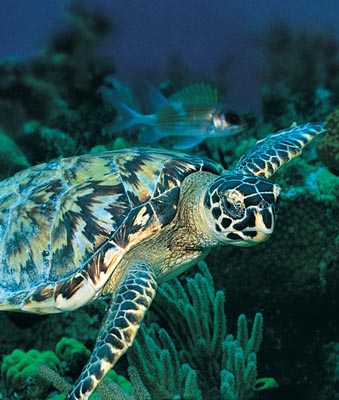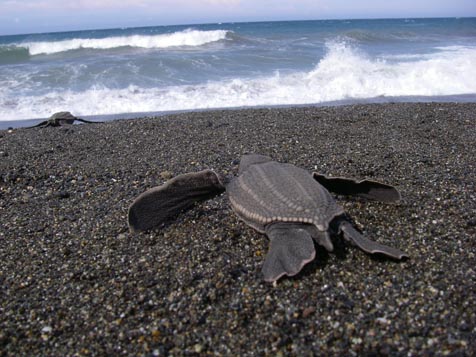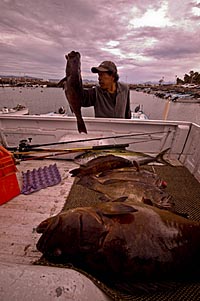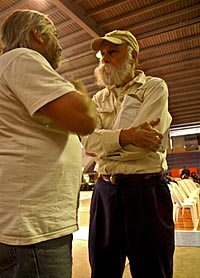Turning Science into Social Change
Ideals of Community Involvement Surface at the 2008 International Sea Turtle Symposium

Sea turtles are animals that many Californians equate with tropical beaches and Caribbean isles. Even in Santa Barbara, where environmental stewardship and marine sanctuaries reign supreme, most people know little about the likeable and ancient reptiles. However, every winter, Pacific leatherback sea turtles travel through the Southern California Bight and the Santa Barbara Channel to their foraging grounds, which stretch from Point Conception to Mendocino. There, coastal upwelling provides an abundance of the jellyfish that form the basis of their diet.
Because all seven species of sea turtles worldwide are either endangered or threatened, sea turtle biologists and conservationists face challenges ranging from beach development to a taste for turtle meat as they study these ancient creatures and try to develop ways to protect them and revive their once great numbers. Every year the International Sea Turtle Symposium is held at a different location around the world. This year’s-the 28th-was held in Loreto, Baja California Sur, Mexico, concurrent with the annual meeting of Grupo Tortuguero, a group of scientists, conservationists, fishermen, and indigenous peoples who have been working together since 1999 to create conservation strategies that can help both the turtles and local populations living near nesting beaches.
Titled “Native Oceans,” the central theme of this year’s conference was cooperation and understanding between conservationists and the people who live, work, and play in the habitat and foraging areas of marine turtles. This idea, although not new, has become more prevalent recently. “The popularity of getting locals this involved is far more than ever before,” said Jack Frazier, a scientist with the Smithsonian Institution’s Conservation and Research Center. “For years, there’s been the realization that academics can’t just stand up and tell people what to do,” he said. “In Latin American and Caribbean countries, a large part of the population is marginalized, and involving those folk in conservation keeps them from killing and eating turtles.”

A Struggle for Survival
At certain times every year, sea turtles gather offshore near nesting beaches around the world to breed. Having swum what is generally thousands of miles to get there, the sea turtles often face a competitive mating process. The female turtles have little time to forage for food before they come ashore and begin laying eggs. They usually choose a spot a few hundred yards from where they nested the year before, and often close to the beach upon which they hatched. Throughout the course of the nesting season, a female sea turtle typically lays two to three clutches-or groups-of eggs, which for most species contains an average of 80 to 120 eggs.
On land, sea turtles are clumsy and slow, so coming out of the water-usually at night-to nest is a tedious, tiring process. Once ashore, the turtle looks for a suitable place to dig a hole for her eggs, often finding that access to the beach has been limited by coastal armoring or development. Other threats to the nesting process include poachers, dogs, and other animals that may disturb or harm the turtle while she is laying eggs. Once she does find a spot though, the turtle digs with her rear flippers, buries the eggs, and throws sand across the nest to obscure it. The female then leaves, never returning to the same nest, and only coming ashore again to lay another clutch of eggs On average, it takes about 60 days for sea turtles to hatch. Pushing themselves from the nest, the tiny hatchlings face a variety of hazards when they emerge. Crabs, birds, and other predators await the bite-sized reptiles, and the disorienting presence of electric lights and coastal development lengthens the amount of time it takes for the hatchlings to make it safely to the water. Even those that do make it into the ocean are prone to another set of aquatic predators and dangers, the threat of which does not diminish until-if lucky enough-the small turtles grow considerably larger. Most sea turtles spend their first two to three years-known as the “lost years”-floating aimlessly in ocean currents and feeding on microscopic organisms.
Although sea turtles lay a lot of eggs, only one out of every 1,000 eggs will become a breeding adult turtle. When pressure is put on adult sea turtle populations by human activities such as fishing, dredging, or poaching, their already slim margins for survival become even smaller. That is why conservationists spend so much time studying their nesting and feeding behaviors, examining threats, and developing what they hope are effective methods of conservation.

Leaders at the Symposium
Located on the Sea of Cortez, Loreto is an historic mission town that, while somewhat remote from any major urban centers, is a cultural hub in Baja California Sur. However, despite its thriving tourist economy and influx of foreign dollars, there are many who still face a daily struggle for survival. The area fishermen are certainly no exception. I spoke with a man named Mario who, until recently, was poaching turtles and their eggs when they came up on the beach to nest in the summer. Since meeting conservationists, however, and becoming better educated about the importance of each hatchling in the bigger picture, he has become a dedicated conservationist himself, using his thorough knowledge of the turtles to help ensure their survival.
There were many people attending the symposium who were either like Mario, or ordinary people who one day decided that something needed to be done. One such person was Supraja Dharini, who formed the Tree Foundation to raise awareness about nesting turtles on the beaches near Chennai, India-located on the southeast coast near Sri Lanka. In 2001, shortly after watching a documentary about famed primatologist Jane Goodall-in which Goodall charged that each person can make a difference-Dharini saw a sea turtle, which had been killed by fishing nets, laying on the beach. It was then that she decided to start an environmental program to educate people so that they could take care of nesting turtles. With the help of volunteers, she created a youth education program that got local kids involved in the conservation process. “We explained to the youth how they live on the wealth of the ocean,” Dharini said. “A lot of their families are fishermen. Our first year, we protected 22 nests. Last year, we protected 107 nests-8,850 eggs!”
Grupo Tortuguero, of which indigenous groups form a large part, held workshops and recognition ceremonies at the symposium. The Comcaak Indians-commonly known as the Seri tribe-hail from the interior of Baja not far from Loreto. They acted as a host group, holding gift exchanges and sharing honors with visitors. During the ceremonies, everyone watched in silence as tough fishermen, Indians, and aboriginal people from around the world sat face-to-face and shared their feelings about the spiritual meaning of sea turtles and why it is so important to preserve them.
Grupo Tortuguero is currently operated under the management of ProPeninsula-a nonprofit started as a graduate school project by Kama Dean and Chris Pesenti in 2001 at the University of California, San Diego. Beginning with a few public outreach programs scattered around Baja, they eventually linked up with Grupo Tortuguero and now manage more than 400 people in 50 different communities. Since Grupo Tortuguero has become so strongly supported, it will soon break off and function on its own, allowing ProPeninsula to manage other projects and keep the ball rolling. “It’s difficult to tell what impact this has had on turtle populations in such a short time,” said Dean, “but we’re trying to evaluate how consumption, bycatch, and perceptions have changed.” By educating fishermen about the long-term economic benefit of eliminating destructive bycatch, or inadvertently catching one species when fishing for another, they’ve been able to get some of them to change the way they fish.
Locals and Activists
While in Loreto, I decided to ask where I might find some nesting beaches and possibly some people involved in monitoring turtles. Mario pointed me in the right direction, and I found myself following a Mexican fisherman and his family-all packed into an old Toyota pickup-south to the town of Lin¼i. This fisherman, who did not share his name, pointed out some areas on the beach marked with sticks that were supposed to be turtle nests. He seemed a little nervous; I couldn’t tell if it was because he thought I was a poacher, because he was a poacher, or because he was just shy, but he told me that people from the town watch the nests to make sure they’re not tampered with.
It being the middle of winter, there were only a few fishermen there, cleaning up their gear, getting ready to go home for the evening. The area attracts a lot of visitors from the U.S., but most of them were camping in an RV “park” nearby and weren’t interested in what the fishermen were up to. Then, some of the fishermen began to shout, “¡Hay Pancho!” to an elderly gringo making his way up the beach with his dogs. Pancho turned out to be Frank Hester, who had moved to Santa Barbara as a boy in 1938. He was excited to meet me and tell me about the foundation he is running in Baja.
Now living in Lin¼i, Hester operates an educational foundation called AssistED that sends rural Mexican kids to high school in Loreto who normally wouldn’t have the money or the opportunity. He told me that some of the ranches in the interior are so remote, even if the ranchers could afford high school tuition, it is impractical for their children to attend due to a lack of public transportation and lodging in town. AssistED attempts to remedy these problems by providing route vans, dormitories, and scholarships for students. Although not connected with the symposium, Hester was another great example of one person deciding that he wants to make a difference.

The collection of people drawn to Loreto for the symposium-from project leaders to fishermen to student volunteers to developers and hoteliers-were all there to make a change. “It’s inspiring to work with people who are passionate about what they do,” said Wallace J. Nichols, a scientist with the Ocean Conservancy, the founder of Grupo Tortuguero, and president of this year’s symposium. He saw incorporating the annual Grupo Tortuguero meeting into the symposium as a way to keep people fired up on conservation long after they’ve left Loreto. “There’s something about the way we’re doing [Grupo Tortuguero] that we don’t lose anybody. It just keeps on getting bigger and bigger, and people keep coming back to these meetings. You’ve got to make it fun and make it feel like a family reunion that people can’t miss. There’s some magic to it that I don’t really understand.”
Indeed, the Sea Turtle Symposia attract a cadre of regulars too, with people traveling all over the world to attend every year. The reason is that the symposium is about more than just studying sea turtles, contends the Smithsonian’s Jack Frazier. “Turtles can be used as a flagship species,” he said. “Like pandas, which people think are cute and loveable, they can be used for communication. In the end, this isn’t a scientific event, this is a socio-political event. When communities can get stoked on turtles and work together, they can solve a variety of problems.”



